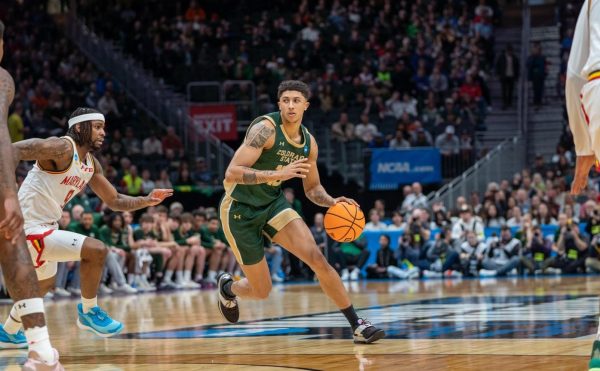Welcoming back ancestors: The importance of Día de los Muertos
Collegian | Garrett Mogel
A member of the Grupo De Danza Quetzalcoatl finishes an Aztec dance originating from the town Jalisco in Mexico during the Dáa de los Muertos celebration in Old Town Square Oct. 28.
October 31, 2022
One of the most prevalent ways diversity is promoted in local communities is by observing different cultural celebrations found between community members.
These holidays carry traditions significant to ethnic communities and serve as a learning opportunity in the importance of cultural ideologies. Día de los Muertos is one such holiday.
“A lot of (Día de los Muertos) is putting joy back into something that can be perceived as so devastating,” said Jamie Rasmussen, program director at The BIPOC Alliance. “In western culture, connection to death is very separate; … in Hispanic culture, it is celebrated.”
Much of Día de los Muertos focuses on the celebration of the spiritual return of ancestors and the aspect of collective healing, giving a chance to “mourn and celebrate those who have passed together,” Rasmussen said.
“I feel like this day brings everyone together, and it gives us permission to believe in something other than life and death,” said Mayra Orozco, community engagement coordinator at The BIPOC Alliance.
Many of the traditions practiced during Día de los Muertos center on reconnecting with those who have died. From the decoration of calaveras — sugar skulls — to public gatherings filled with Aztec dance, face painting and mariachi, the rich traditions of Día de los Muertos bridge the gap between life and death through visualizations of these ideas themselves.
One of the most important symbols are the ofrendas: altars in the homes of families honoring loved ones who have died. Ofrendas are commonly decorated with “things like favorite foods or drinks and pictures of the ancestors you want to have come visit you — … items to welcome our ancestors back to visit for that night,” Rasmussen said.
Rasmussen gave an example of her own ofrenda, which is dedicated to her father, who died last year. Items of importance decorate the ofrenda, from photos of him to a Budweiser, a favorite drink of his, “open and full for him so that he could drink it,” Rasmussen said.
Additional items on the ofrenda consist of pan de muerto and marigold flowers. Pan de muerto is a sweet bread pastry baked to resemble bones, according to the Dayofthedead.holiday website. Marigolds represent how an ancestor finds their way home by means of the “strong, beautiful scent,” Rasmussen said.
Día de los Muertos symbolizes a sense of unity and representation within the Latinx community, allowing members to connect back to cultural traditions.
“It gives me a sense of belonging,” Orozco said. “Representation matters; … it gives us a day to reclaim parts of our culture and parts of ourselves.”
El Centro, Colorado State University’s Latinx community support network, carries this representation through the preservation and practice of Día de los Muertos traditions at CSU.
Michelle Cadena, assistant director of El Centro, noted the importance of Día de los Muertos to represent diverse traditions, as variations of the holiday celebrations span across different Latinx countries, such as Guatemala, Honduras and El Salvador.
“Our Latinx community has different background experiences, and also there’s a lot of different traditions that are held for Día de los Muertos,” Cadena said. “They are very broad — they are very different and similar at the same time.”
Through Día de los Muertos, Cadena said she wants to give “visibility to a lot of traditions that are important to our community,” acting as a learning experience for people unfamiliar with the culture. It can also gives the Latinx community at CSU a home in which they connect with others through celebration.
“I think being part of the Latinx community and having people recognize the things that are important to your culture (and) the things that you do, … it makes you feel like you belong (and) … what you celebrate is also being seen and validated,” Cadena said.
Cadena urged non-Latinx community members to recognize the separation of Día de los Muertos from Halloween. Given Western culture’s history of appropriating the unique traditions of the Latinx community, it is important to not turn important hallmarks of culture and heritage into Halloween costumes.
“Whatever traditional costumes La Catrina wears (or) what we do for our altar are very important for Nov. 1 and 2 and not to be utilized as costumes for Halloween,” Cadena said.
With these considerations in mind, Cadena invited community members to learn more about Día de los Muertos and enjoy the traditions of the holiday.
“I see it as a very beautiful tradition and part of our culture,” Cadena said. “It highlights those people who we loved and who we want to continue to remember.”
Reach DJ Vicente at life@collegian.com or on Twitter @DeejMako.






alicia higgins • Feb 29, 2024 at 9:19 am
That’s me in the blue dress with the skeleton makeup!